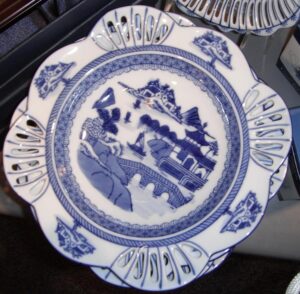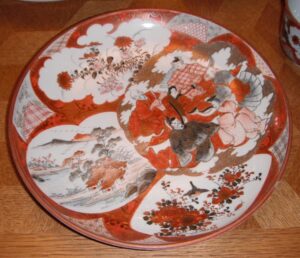The recent sale of a Chinese Ming dynasty bowl at auction purchased for $35 at a New Haven, Connecticut yard sale has become quite a big story in the art and antiques world. The blue/white porcelain bowl made using a method of ceramic painting known as “heaped and piled” application in a deep cobalt blue that reads as a violet color was found at a New Haven area yard sale not far from the prestigious campus of the Yale University. It was purchased by a savvy yard sale shopper who found a real bargain and paid $35 for the item. After some time, the shopper decided to sell it and contacted Sotheby’s auction house to market and sell the find. While this is an interesting story in its own right, why does this story matter to you?
Here are three reasons why a $35 yard sale bowl sold for $721,000 and how it affects you.
“It’s Ming!”

You’ve probably heard the term Ming in everyday conversation with phrases like “it dates back to the Ming dynasty”, “that is as valuable as a Ming vase”, “that is so old that it could be Ming”. The word Ming and the phrase Ming dynasty has come into our language to represent something rare, precious, valuable, and beautiful these days. As an art historian, it might help to know why the Ming dynasty and all things Ming are revered and held in such high esteem.
The Chinese Ming dynasty lasted a very long time. China’s Ming dynasty lasted from 1368 until 1644 and represented a period when China’s rulers exercised great and widespread political and cultural influence over much of the Far East. Actually, the Ming dynasty exercised such influence over the regions of the Far East, as far west as Turkey, and as far south as Myanmar and Vietnam. This impact brought China great prosperity and the objects that derived from the Ming dynasty or were made during the Ming dynasty in China were the best of the best.
Getting back to that little blue/white porcelain bowl found in New Haven, CT sitting on a yard sale table, the big deal surrounding that was the piece was in excellent condition for its age—it dated to the Yongle period of Ming dynastic rule or the 1400s in China—and it has characteristics known to some of the best ceramic artists working for the Chinese court. High quality materials and the best craftsmanship were used in order to make that bowl as that was the standard at the time. In short, the reason why this bowl is so special goes back to the old saying: “It’s Ming!”
Why was Estimate Low?
Another chapter in this story of the yard sale Ming bowl is the auction house’s role. Sotheby’s auction house in New York, NY, USA sold the Ming dynasty bowl for $721,800 at auction on a pre-auction estimate of $500,000. That’s right, Sotheby’s reported that, months before the auction, that they expected the bowl to sell for between $300,000 and $500,000 US Dollars once the auction took place. So, before the sale, Sotheby’s, the long-established prominent auction house, made a stab at estimating the value of this small Ming dynasty blue/white porcelain footed bowl.
It was reviewed, identified, compared with other known Ming bowls in museums and private collections, and appraised by the auction house’s specialists. These specialists in analyzing the market arrived at the $300,000-$500,000 pre-auction estimate. Basically, they thought it would sell for anywhere between $300,000 to $500,000 at auction and now we know that, well, to put it bluntly, they were wrong. The estimate was too low for the Ming bowl. It sold for much more than $500,000. But how much more? Didn’t it sell for $721,000 as stated in the press. Well, sort of but not really.
When I was asked about the auction estimate during a live TV appearance on Pittsburgh’s CBS 2 TV, I told the TV interviewers–two seasoned news anchors–that the Ming bowl would sell for much more than the pre-auction estimate. I said that the $500,000 estimate is low. How did I know it was low? Years of experience as an appraiser and time in analyzing the markets for art, antiques, and collectibles has taught me a lot about how auctions work and how the media loves a good yard sale/auction story. Throw in a Ming vase and you’ve got fodder for the mill for months on air. That gives the auction house free press to market and sell the piece and it gives news anchors lots to talk about to fill the air.
How did I know that the pre-auction estimate was low? Ming dynasty pieces of lower quality have sold for more than $500,000 at auction and most high-profile pieces –Ming and otherwise–sell for more than the auction estimate by design. And when a work of art or antique exceeds its pre-auction estimate, that is good for the auction house because then there is a compelling story about the same object after the auction ends stating that the auction house exceeded expectations which gives the auction house double the press coverage—before and after the auction took place to talk about the auction—a two for the price of one situation so to speak. All press is good press even if the press reveals that the auction house was off base with its pre-auction estimate by nearly 20%.
What? They sold it for more than the estimate, how were they off base, you ask? The auction house was off base or dare I say wrong because the bowl didn’t sell for between $300,00 and $500,000. It sold for $580,000. That means that Sotheby’s estimate was off by $80,000 or nearly 16% off the high estimate value on this item. You’d think the appraisers could get closer to the true appraised value for the auction estimate, but maybe that wasn’t what they were aiming for.
I know what you are saying… wait a minute. I thought the Ming dynasty, 15th Century, blue/white porcelain bowl sold for $721,000. Wasn’t $721,000 the final sold value? Yes and no. Yes, $721, 000 was the final sale number that was reported and it was the amount of money that Sotheby’s took into its coffers because of this sale. But if you do the math–and everyone loves to do the math– you will realize that the bowl itself sold for $580,000. The other moneys related to this auction are fees.
That’s right, the other moneys totaling $721,000 were additional auction house fees. There is a buyer’s fee which is a fee a buyer pays for the privilege to buy the item and a seller’s fee which is the fee that a seller pays to work with the auction house so the piece can sell for top dollar. Not to mention other fees like storage, insurance (don’t forget insurance fees), marketing, etc. That’s right. The auction house brought in $141,000 in auction house fees when they sold that little Chinese bowl in New York. That is how the auction house arrived at $721,000.
So, that brings us to the future of auction houses and evaluating market value. The next time a bowl like that goes to auction, albeit rare, the number that reporters will be stating as a pre-auction estimate will probably be closer to $725,000 than it will be to $500,000. Next time no one will remember the $500,000 estimate on this Ming bowl as the market will be interested in some hypothetical Ming bowl found in a laundry room in Kansas City for example worth an estimated $725,000. The price for every other future Ming bowl that goes to auction just increased. How do I predict the future like this when it comes to art and antiques? You must understand the history of the past.
This story affects all of us. Why? Learn about how auctions work. If you are buying, selling or just have an interest in art and antiques, understanding how auctions work will help buy or sell anything. You don’t have to be selling a priceless Ming bowl masterpiece to realize that this kind of information can help you when you are buying stuff from a thrift store or estate sale or dare I say yard sale and it can be a great teacher if you are selling items online via ebay.com or etsy.com. Learn how the auctions work to sell for top dollar and to position the market so your future offerings will sell for more money.
Yard Sale or Museum Bowl?

When you consider this Ming bowl, remember a few things. The piece is not moriage or Imari or Kutani style. The piece has a closer connection to the blue/white ceramics known as Cantonware. Yet, make no mistake, this bowl was not some run of the mill item. It was very old—made around the same time that Leonardo was painting the Mona Lisa—and very beautiful. It was one of only six (6) known to exist in the world along with others that are now in the British Museum, the Victoria and Albert Museum, the National Museum of Taipei, among others.
The Ming bowl is a museum quality piece of the Ming dynasty in blue/white porcelain featuring quatrefoil motifs, flowers of lotus, peony, chrysanthemum, and pomegranate in a stylized pattern, and a rare ringed footed form. While it started out from a yard sale, it belongs in a museum and will someday probably end up there.
What other lessons have we learned from the sale of this little blue/white porcelain bowl? When you are thinking about mapping out your yard sale journey this weekend, consider where the closest university campus is located. I wasn’t surprised that this bowl ended up at a New Haven yard sale close to Yale University. Perhaps at one time in its long history, someone knew how important that little bowl was and it inadvertently ended up on the front lawn with a $35 yard sale sticker on it. Maybe next time, that yard sale shopper could be you.
I can also help you identify and value your yard sale find during a video call or you can send me photos. Check out the options and get started. Watch videos on my YouTube channel as I show you how to identify and sell your yard sale finds.
Read More »

